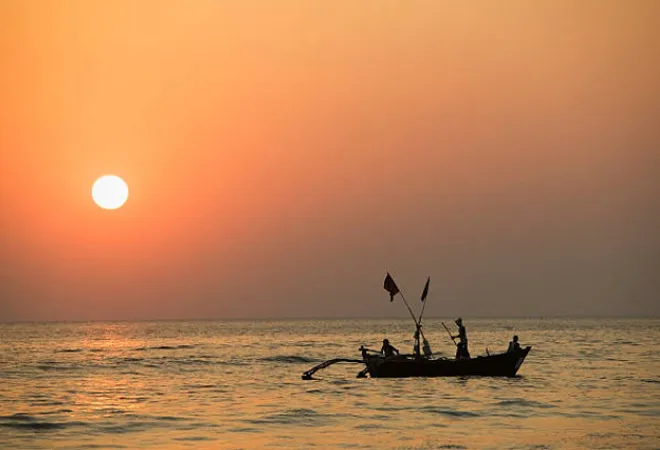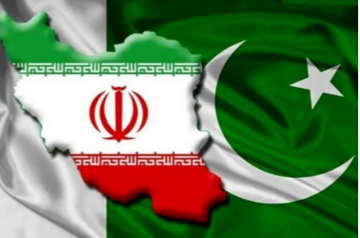
This piece is part of the essay series, Strategic High Tide in the Indo-Pacific: Economics, Ecology, and Security.
The Bay of Bengal is a hot spot for illegal, unregulated and unreported (IUU) fishing. Unauthorised tuna longlining and transshipment takes place on the high seas in contravention of Indian Ocean Tuna Commission (IOTC) conservation and management measures. There is underreported and/or non-reporting to the coastal state and the IOTC. There are vessels operating under flags of convenience, stateless vessels using falsified registry documentation, vessels obscuring markings, having no vessel markings or failing to have vessel documentation. This is all part of
the wider problem in the Indian Ocean of IUU fishing.
In the Pacific, the Exclusive Economic Zones (EEZs) of the 17 Pacific Islands Forum Fisheries Agency (FFA) members cover the equivalent to 28 percent of the world’s EEZs. In 2019, the total tuna catch was 2.96m mt in the western central Pacific Ocean—55 percent of global tuna production. Tuna caught in FFA members’ waters is valued at US $2.5 billion. The industry provides employment for more than 22,000 people mainly onshore, although there are crews and observers on vessels. The Pacific island fleet is growing and about a third of the 255 purse seiners vessels active in the region fly Pacific island country flags. In contrast, the offshore tuna fishery in the longline fishing sector is dominated by fishing vessels flagged to distant-water fishing nations primarily China, Japan, Taiwan, South Korea, Philippines and the US.
For the Pacific islands, as in other oceans, IUU fishing comes in many shapes and forms and can have huge costs. But, in many ways, the western central Pacific represents the gold standard of how to combat the persistent and pressing problem of IUU fishing.
Nature of IUU fishing
The term IUU fishing has those three components built into its name:
Illegal, unregulated, unreported. Each of those three components are not necessarily mutually exclusive. If a rogue vessel is fishing illegally, it is very unlikely that that vessel is then going to record its activities in a logbook for accountability. So that activity is
unreported. Similarly, rogue vessels are usually either stateless or operating under flag states that have lax regulatory environment. Hence, they are
unregulated activities as well. Thus, there is an enormous crossover between each of the three components. At the global level, it is the
unreported aspect which is the most insidious and largest component of the IUU risk. Unreported also includes underreporting, misreporting and non-reporting. Unreported fishing crosses into unregulated fishing and illegal fishing.
There is underreported and/or non-reporting to the authorities, vessels operating under flags of convenience, stateless vessels using falsified registry documentation, vessels obscuring markings or failing to have vessel documentation.
There are a range of commercial incentives for misreporting or non-reporting or underreporting of activities and catch. It may be to avoid quota restrictions, or to get around fees and charges and levies. It may be to hide interactions with protected species, or mask activities in areas that they are not supposed to be taking place. So, if that underreporting and/or
misreporting is taking place intentionally or even recklessly—simply by the industry not exercising the care and attention it should—then it falls squarely into IUU fishing.
Compromised data impacts on the accuracy of the stock assessments. It undermines the ability to monitor and implement management arrangements. Unreported fishing has the potential to rob communities of economic and social benefits that they should be gaining from the fisheries resources that they own. The key point with unreported fishing is that it is important that each country undertake an assessment of what their unreported risk is and deploy the tools that make the most sense to address that risk.
Unregulated fishing is the most frustrating part of the formula because unregulated fishing really points to a failure of governments to get together and cooperate and develop management regimes and arrangements that will govern a fishery. A few key messages from this before looking at the Pacific experience and its lessons for the Indian Ocean.
First, IUU fishing is a global problem and it needs a global solution. There is not a single country, regional fisheries management organisation or NGO that can solve the problem of IUU fishing on its own. Second, one can’t afford to only focus on the illegal fishing component of IUU fishing. Third, unreported, including misreported fishing activities, has even greater flow on risks to fisheries management regimes than illegal fishing, through the compromise of data. Fourth, unregulated fishing must be dealt with at the government level. Fifth, each country needs to be keeping a continual eye on what IUU fishing risks there are for their country. While it is not possible to respond to every single component of IUU, it is important that the most significant ones are addressed. Lastly, as each coastal state relies on support from another to be able to adequately address their IUU fishing risks, cooperation is key.
Pacific lessons on IUU fishing
The key lesson for the Indian Ocean from the Pacific in combatting IUU fishing is that a region can multiply monitoring control and surveillance (MCS) effectiveness through regional cooperation amongst coastal states. There is a significant opportunity for Pacific information exchange with organisations in the Indian Ocean region on vessel monitoring systems and data information sharing standards. The Pacific is now moving forward on electronic monitoring systems used to complement and enhance fisheries observers.
There is a real opportunity for the Indian Ocean to learn here from the
Regional Fisheries Surveillance Centre in Honiara, Solomon Islands. The Indian Ocean could learn much from the Pacific about
standardised observer training of independent observers at a national level; it is much less developed in the Indian Ocean than the Pacific.
The so-called
Group of 16 Like-Minded Coastal States of the Indian Ocean Tuna Commission (G16), is the closest group in the Indian Ocean to a
Pacific Islands Forum Fisheries Agency coastal states body in Pacific. G-16 could take up the IUU issue as a major challenge and build capacity and trust among its members through engagement with Pacific fishing bodies.
In the Indian Ocean, there is a lot of overlap in limited fisheries reporting. Some reporting species within various Indian Ocean fishing bodies go to three different entities. There are opportunities in the Indian Ocean to collaborate here with the Pacific, potentially assisting on options to establish one central management of reporting data
.
The Indian Ocean could benefit from greater interaction with the Pacific fisheries bodies on the development of
harmonised minimum terms and conditions for fisheries access to coastal states EEZs that help to prevent one island country being played off against another by major fishing states. Managing transhipment is a big issue in the Indian Ocean:
Information exchange with the Pacific on transhipment observer programs would be useful.
The Indian Ocean could also benefit from greater interaction with the Pacific fisheries bodies on the development of harmonised minimum terms and conditions for fisheries access to coastal states EEZs.
Much more of the fishery takes place in the high seas in the Indian Ocean, not in EEZs unlike the Pacific: For that reason, it is much harder for Indian Ocean coastal states to take control of their fishery. But Indian Ocean coastal states have port state control, to influence and unite their positions over what happens beyond 200 miles. The role of
port state control is an area for useful cross-ocean information exchange.
Unlike in the Pacific, Indian Ocean does not have a single independent provider of fisheries science. The Pacific has been fortunate to have that independent science capability through the
Pacific Community regional organisation in Noumea. There are opportunities in the Indian Ocean to look at the Pacific model of independent science input. The Pacific has the advantage of having completed a
comprehensive quantification study of IUU.
On 14 December 2021,
FFA released an update of the study that estimated the total annual volume of tuna product harvested or transhipped in the Pacific involving IUU activity during 2017-19 to be 192,186 tonnes, worth some US $333 million (ex-vessel value). This compared with the earlier study conducted between 2010-15 where IUU was estimated at 306,440 tonnes, worth about $616 million.
A quantification study would provide an incentive and data for Indian Ocean coastal states to work together on the IUU fishing problem.
There is a useful role for non-government organisations in the Indian Ocean, such as
Global Fishing Watch.
Fish-I Africa brings together national enforcement authorities, regional organisations and international experts to combat illegal fishing in the western Indian Ocean. The
Stop Illegal Fishing group is working with African countries. These NGOs would benefit from interacting with Pacific regional fisheries bodies on the IUU issue. The Indian Ocean and the Pacific would also benefit from closer cooperation in relation to global discussions on IUU in fora such as the FAO’s Committee on Fisheries.
But this all will not happen overnight. The best place to start in the Indian Ocean is to build informal networks of trust amongst fisheries MCS officers across the region to build trust. It is probably easier for the Indian Ocean to cooperate on IUU than some of the thornier issues on fisheries management. That is true even if at some much later point the region ends formalising its own fisheries coastal states group into a treaty arrangement. The G16 group of the IOTC is currently informal but could potentially, (or another separate group), be formed through formal treaty negotiations.
The views expressed above belong to the author(s). ORF research and analyses now available on Telegram! Click here to access our curated content — blogs, longforms and interviews.




 PREV
PREV


